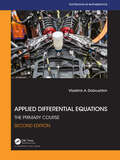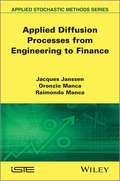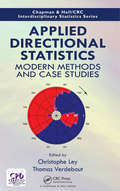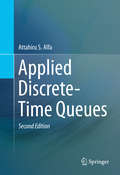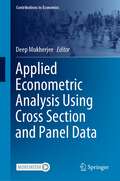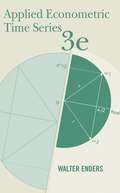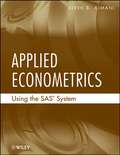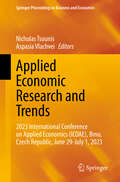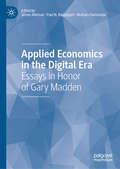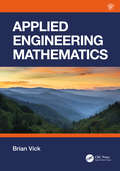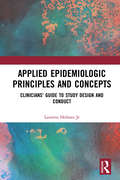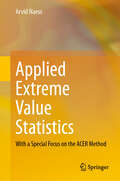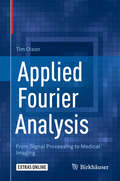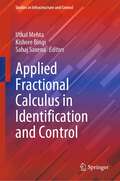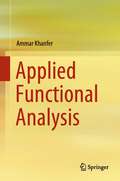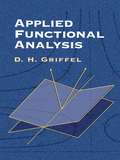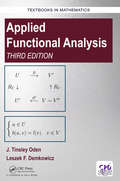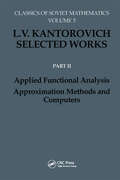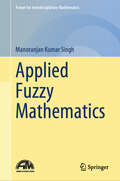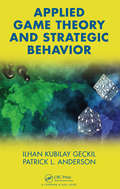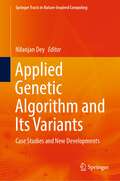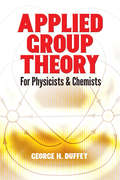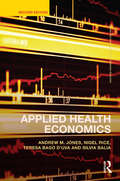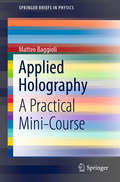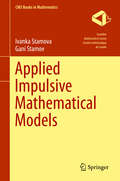- Table View
- List View
Applied Differential Equations: The Primary Course (Textbooks in Mathematics #18)
by Vladimir A. DobrushkinThis book started as a collection of lecture notes for a course in differential equations taught by the Division of Applied Mathematics at Brown University. To some extent, it is a result of collective insights given by almost every instructor who taught such a course over the last 15 years. Therefore, the material and its presentation covered in this book were practically tested for many years. This text is designed for a two-semester sophomore or junior level course in differential equations. It offers novel approaches in presentation and utilization of computer capabilities. This text intends to provide a solid background in differential equations for students majoring in a breadth of fields. Differential equations are described in the context of applications. The author stresses differential equations constitute an essential part of modeling by showing their applications, including numerical algorithms and syntax of the four most popular software packages. Students learn how to formulate a mathematical model, how to solve differential equations (analytically or numerically), how to analyze them qualitatively, and how to interpret the results. In writing this textbook, the author aims to assist instructors and students through: •Showing a course in differential equations is essential for modeling real-life phenomena.•Stressing the mastery of traditional solution techniques and presenting effective methods, including reliable numerical approximations. •Providing qualitative analysis of ordinary differential equations. The reader should get an idea of how all solutions to the given problem behave, what are their validity intervals, whether there are oscillations, vertical or horizontal asymptotes, and what is their long-term behavior.•The reader will learn various methods of solving, analysis, visualization, and approximation, exploiting the capabilities of computers. •Introduces and employs Maple™, Mathematica®, MatLab®, and Maxima. •This textbook facilitates the development of the student’s skills to model real-world problems. Ordinary and partial differential equations is a classical subject that has been studied for about 300 years. The beauty and utility of differential equations and their application in mathematics, biology, chemistry, computer science, economics, engineering, geology, neuroscience, physics, the life sciences, and other fields reaffirm their inclusion in myriad curricula. A great number of examples and exercises make this text well suited for self-study or for traditional use by a lecturer in class. Therefore, this textbook addresses the needs of two levels of audience, the beginning and the advanced.
Applied Diffusion Processes from Engineering to Finance (Wiley-iste Ser.)
by Jacques Janssen Raimondo Manca Oronzio MancaThe aim of this book is to promote interaction between engineering, finance and insurance, as these three domains have many models and methods of solution in common for solving real-life problems. The authors point out the strict inter-relations that exist among the diffusion models used in engineering, finance and insurance. In each of the three fields, the basic diffusion models are presented and their strong similarities are discussed. Analytical, numerical and Monte Carlo simulation methods are explained with a view to applying them to obtain the solutions to the different problems presented in the book. Advanced topics such as nonlinear problems, Lévy processes and semi-Markov models in interactions with the diffusion models are discussed, as well as possible future interactions among engineering, finance and insurance. Contents 1. Diffusion Phenomena and Models.2. Probabilistic Models of Diffusion Processes.3. Solving Partial Differential Equations of Second Order.4. Problems in Finance.5. Basic PDE in Finance.6. Exotic and American Options Pricing Theory.7. Hitting Times for Diffusion Processes and Stochastic Models in Insurance.8. Numerical Methods.9. Advanced Topics in Engineering: Nonlinear Models.10. Lévy Processes.11. Advanced Topics in Insurance: Copula Models and VaR Techniques.12. Advanced Topics in Finance: Semi-Markov Models.13. Monte Carlo Semi-Markov Simulation Methods.
Applied Directional Statistics: Modern Methods and Case Studies (Chapman & Hall/CRC Interdisciplinary Statistics)
by Christophe Ley Thomas VerdeboutThis book collects important advances in methodology and data analysis for directional statistics. It is the companion book of the more theoretical treatment presented in Modern Directional Statistics (CRC Press, 2017). The field of directional statistics has received a lot of attention due to demands from disciplines such as life sciences or machine learning, the availability of massive data sets requiring adapted statistical techniques, and technological advances. This book covers important progress in bioinformatics, biology, astrophysics, oceanography, environmental sciences, earth sciences, machine learning and social sciences.
Applied Discrete-Time Queues
by Attahiru S. AlfaThis book introduces the theoretical fundamentals for modeling queues in discrete-time, and the basic procedures for developing queuing models in discrete-time. There is a focus on applications in modern telecommunication systems. It presents how most queueing models in discrete-time can be set up as discrete-time Markov chains. Techniques such as matrix-analytic methods (MAM) that can used to analyze the resulting Markov chains are included. This book covers single node systems, tandem system and queueing networks. It shows how queues with time-varying parameters can be analyzed, and illustrates numerical issues associated with computations for the discrete-time queueing systems. Optimal control of queues is also covered. Applied Discrete-Time Queues targets researchers, advanced-level students and analysts in the field of telecommunication networks. It is suitable as a reference book and can also be used as a secondary text book in computer engineering and computer science. Examples and exercises are included.
Applied Econometric Analysis Using Cross Section and Panel Data (Contributions to Economics)
by Deep MukherjeeThis book is a collection of 20 chapters on chosen topics from cross-section and panel data econometrics. It explores both theoretical and practical aspects of selected cutting-edge techniques which are gaining popularity among applied econometricians, while following the motto of “keeping things simple”. Each chapter gives a basic introduction to one such method, directs readers to supplementary references, and shows an application. The book takes into account that—A: The field of econometrics is evolving very fast and leading textbooks are trying to cover some of the recent developments in revised editions. This book offers basic introduction to state-of-the-art techniques and recent advances in econometric models with detailed applications from various developing and developed countries. B: An applied researcher or practitioner may prefer reference books with a simple introduction to an advanced econometric method or model with no theorems but with a longer discussion on empirical application. Thus, an applied econometrics textbook covering these cutting-edge methods is highly warranted; a void this book attempts to fills.The book does not aim at providing a comprehensive coverage of econometric methods. The 20 chapters in this book represent only a sample of the important topics in modern econometrics, with special focus on econometrics of cross-section and panel data, while also recognizing that it is not possible to accommodate all types of models and methods even in these two categories. The book is unique as authors have also provided the theoretical background (if any) and brief literature review behind the empirical applications. It is a must-have resource for students and practitioners of modern econometrics.
Applied Econometric Time Series (3rd edition)
by Walter EndersThis new edition reflects both sound structure and recent advances in time-series econometrics, such as out-of-sample forecasting techniques, nonlinear time-series models, Monte Carlo analysis, and bootstrapping.
Applied Econometrics Using the SAS System
by Vivek AjmaniThe first cutting-edge guide to using the SAS® system for the analysis of econometric dataApplied Econometrics Using the SAS® System is the first book of its kind to treat the analysis of basic econometric data using SAS®, one of the most commonly used software tools among today's statisticians in business and industry. This book thoroughly examines econometric methods and discusses how data collected in economic studies can easily be analyzed using the SAS® system.In addition to addressing the computational aspects of econometric data analysis, the author provides a statistical foundation by introducing the underlying theory behind each method before delving into the related SAS® routines. The book begins with a basic introduction to econometrics and the relationship between classical regression analysis models and econometric models. Subsequent chapters balance essential concepts with SAS® tools and cover key topics such as:Regression analysis using Proc IML and Proc RegHypothesis testingInstrumental variables analysis, with a discussion of measurement errors, the assumptions incorporated into the analysis, and specification tests Heteroscedasticity, including GLS and FGLS estimation, group-wise heteroscedasticity, and GARCH modelsPanel data analysisDiscrete choice models, along with coverage of binary choice models and Poisson regressionDuration analysis modelsAssuming only a working knowledge of SAS®, this book is a one-stop reference for using the software to analyze econometric data. Additional features include complete SAS® code, Proc IML routines plus a tutorial on Proc IML, and an appendix with additional programs and data sets. Applied Econometrics Using the SAS® System serves as a relevant and valuable reference for practitioners in the fields of business, economics, and finance. In addition, most students of econometrics are taught using GAUSS and STATA, yet SAS® is the standard in the working world; therefore, this book is an ideal supplement for upper-undergraduate and graduate courses in statistics, economics, and other social sciences since it prepares readers for real-world careers.
Applied Economic Research and Trends: 2023 International Conference on Applied Economics (ICOAE), Brno, Czech Republic, June 29-July 1, 2023 (Springer Proceedings in Business and Economics)
by Nicholas Tsounis Aspasia VlachveiThis volume presents new research and trends in applied economic research with special interest in advances in applied macroeconomics, microeconomics, financial economics, international economics, agricultural economics, health economics, marketing, and management. It features contributions presented at the 2023 International Conference on Applied Economics (ICOAE) held in Brno, Czech, Republic including country specific studies from 40 different countries. The contents of this volume is of interest to researchers, scholars, academics and policy makers within applied economics.
Applied Economics in the Digital Era: Essays in Honor of Gary Madden
by James Alleman Paul N. Rappoport Mohsen HamoudiaGary Madden was a renaissance man with respect to the nexus between information and communications technology (ICT) and economics. He contributed to a variety of fields in ICT: applied econometrics, forecasting, internet governance and policy. This series of essays, two of which were co-authored by Professor Madden prior to his untimely death, cover the range of his research interests. While the essays focus on a number of ICT issues, they are on the frontier of research in the sector. Gerard Faulhaber provides a broad overview of how we have reached the digital age and its implications. The applied econometric section brings the latest research in the area, for example Lester Taylor illustrates how own-price, cross-price and income elasticities can be calculated from survey data and translated into real income effects. The forecasting section ranges from forecasting online political participation to broadband’s impact on economic growth. The final section covers aspects of governance and regulation of the ICT sector.
Applied Engineering Mathematics
by Brian VickUndergraduate engineering students need good mathematics skills. This textbook supports this need by placing a strong emphasis on visualization and the methods and tools needed across the whole of engineering. The visual approach is emphasized, and excessive proofs and derivations are avoided. The visual images explain and teach the mathematical methods. The book’s website provides dynamic and interactive codes in Mathematica to accompany the examples for the reader to explore on their own with Mathematica or the free Computational Document Format player, and it provides access for instructors to a solutions manual. Strongly emphasizes a visual approach to engineering mathematics Written for years 2 to 4 of an engineering degree course Website offers support with dynamic and interactive Mathematica code and instructor’s solutions manual Brian Vick is an associate professor at Virginia Tech in the United States and is a longtime teacher and researcher. His style has been developed from teaching a variety of engineering and mathematical courses in the areas of heat transfer, thermodynamics, engineering design, computer programming, numerical analysis, and system dynamics at both undergraduate and graduate levels. eResource material is available for this title at www.crcpress.com/9780367432768.
Applied Epidemiologic Principles and Concepts: Clinicians' Guide to Study Design and Conduct
by Laurens Holmes, Jr.This book provides practical knowledge to clinicians and biomedical researchers using biological and biochemical specimen/samples in order to understand health and disease processes at cellular, clinical, and population levels. Concepts and techniques provided will help researchers design and conduct studies, then translate data from bench to clinics in attempt to improve the health of patients and populations. This book presents the extreme complexity of epidemiologic research in a concise manner that will address the issue of confounders, thus allowing for more valid inferences and yielding results that are more reliable and accurate.
Applied Extreme Value Statistics: With a Special Focus on the ACER Method
by Arvid NaessThis book does not focus solely on asymptotic extreme value distributions. In addition to the traditional asymptotic methods, it introduces a data-driven, computer-based method, which provides insights into the exact extreme value distribution inherent in the data, and which avoids asymptotics. It therefore differs from currently available texts on extreme value statistics in one very important aspect. The method described provides a unique tool for diagnostics, and for efficient and accurate extreme value prediction based on measured or simulated data. It also has straightforward extensions to multivariate extreme value distributions. The first half provides an introduction to extreme value statistics with an emphasis on applications. It includes chapters on classical asymptotic theories and threshold exceedance models, with many illustrative examples. The mathematical level is elementary and, to increase readability, detailed mathematical proofs have been avoided in favour of heuristic arguments. The second half presents in some detail specialized topics that illustrate the power and the limitations of the concepts discussed. With diverse applications to science, engineering and finance, the techniques described in this book will be useful to readers from many different backgrounds.
Applied Fourier Analysis: From Signal Processing To Medical Imaging
by Tim OlsonThe first of its kind, this focused textbook serves as a self-contained resource for teaching from scratch the fundamental mathematics of Fourier analysis and illustrating some of its most current, interesting applications, including medical imaging and radar processing. Developed by the author from extensive classroom teaching experience, it provides a breadth of theory that allows students to appreciate the utility of the subject, but at as accessible a depth as possible. With myriad applications included, this book can be adapted to a one or two semester course in Fourier Analysis or serve as the basis for independent study. Applied Fourier Analysis assumes no prior knowledge of analysis from its readers, and begins by making the transition from linear algebra to functional analysis. It goes on to cover basic Fourier series and Fourier transforms before delving into applications in sampling and interpolation theory, digital communications, radar processing, medi cal imaging, and heat and wave equations. For all applications, ample practice exercises are given throughout, with collections of more in-depth problems built up into exploratory chapter projects. Illuminating videos are available on Springer. com and Link. Springer. com that present animated visualizations of several concepts. The content of the book itself is limited to what students will need to deal with in these fields, and avoids spending undue time studying proofs or building toward more abstract concepts. The book is perhaps best suited for courses aimed at upper division undergraduates and early graduates in mathematics, electrical engineering, mechanical engineering, computer science, physics, and other natural sciences, but in general it is a highly valuable resource for introducing a broad range of students to Fourier analysis.
Applied Fractional Calculus in Identification and Control (Studies in Infrastructure and Control)
by Kishore Bingi Utkal Mehta Sahaj SaxenaThe book investigates the fractional calculus-based approaches and their benefits to adopting in complex real-time areas. Another objective is to provide initial solutions for new areas where fractional theory has yet to verify the expertise. The book focuses on the latest scientific interest and illustrates the basic idea of general fractional calculus with MATLAB codes. This book is ideal for researchers working on fractional calculus theory both in simulation and hardware. Researchers from academia and industry working or starting research in applied fractional calculus methods will find the book most useful. The scope of this book covers most of the theoretical and practical studies on linear and nonlinear systems using fractional-order integro-differential operators.
Applied Functional Analysis
by Ammar KhanferThis textbook offers a concise and thorough introduction to the topic of applied functional analysis. Targeted to graduate students of mathematics, it presents standard topics in a self-contained and accessible manner. Featuring approximately 300 problems sets to aid in understanding the content, this text serves as an ideal resource for independent study or as a textbook for classroom use. With its comprehensive coverage and reader-friendly approach, it is equally beneficial for both students and teachers seeking a detailed and in-depth understanding of the subject matter.
Applied Functional Analysis (Dover Books on Mathematics)
by D. H. GriffelA stimulating introductory text, this volume examines many important applications of functional analysis to mechanics, fluid mechanics, diffusive growth, and approximation. Detailed enough to impart a thorough understanding, the text is also sufficiently straightforward for those unfamiliar with abstract analysis. Its four-part treatment begins with distribution theory and discussions of Green's functions. Essentially independent of the preceding material, the second and third parts deal with Banach spaces, Hilbert space, spectral theory, and variational techniques. The final part outlines the ideas behind Frechet calculus, stability and bifurcation theory, and Sobolev spaces. 1985 edition. 25 Figures. 9 Appendices. Supplementary Problems. Indexes.
Applied Functional Analysis (Textbooks in Mathematics)
by J. Tinsley Oden Leszek DemkowiczApplied Functional Analysis, Third Edition provides a solid mathematical foundation for the subject. It motivates students to study functional analysis by providing many contemporary applications and examples drawn from mechanics and science. This well-received textbook starts with a thorough introduction to modern mathematics before continuing with detailed coverage of linear algebra, Lebesque measure and integration theory, plus topology with metric spaces. The final two chapters provides readers with an in-depth look at the theory of Banach and Hilbert spaces before concluding with a brief introduction to Spectral Theory. The Third Edition is more accessible and promotes interest and motivation among students to prepare them for studying the mathematical aspects of numerical analysis and the mathematical theory of finite elements.
Applied Functional Analysis. Approximation Methods and Computers: Applied Functional Analysis, Approximation Methods and Computers
by S.S. KutateladzeThis book contains the most remarkable papers of L.V. Kantorovich in applied and numerical mathematics. It explores the principal directions of Kantorovich's research in approximate methods. The book covers descriptive set theory and functional analysis in semi-ordered vector spaces.
Applied Fuzzy Mathematics (Forum for Interdisciplinary Mathematics)
by Manoranjan Kumar SinghThis comprehensive introductory textbook is designed for undergraduate mathematics students who are interested in gaining an in-depth understanding of fuzzy mathematics and its applications. The book covers a wide range of topics, including fuzzy linear equations, fuzzy graphs, fuzzy measures, fuzzy logic, fuzzy topological spaces, fuzzy subgroups, as well as applications of fuzzy mathematics in various other fields. While readers are assumed to be familiar with the concept of fuzzy sets, the book maintains a clear and straightforward approach that makes it easy to follow for students at any level of proficiency. The advanced content is presented in an insightful and accessible manner, empowering students to apply the concepts they learn to real-world problems and applications. Enriched with over 105 solved examples, 133 challenging problems, 185 multiple-choice questions, and 150 true/false statements, this book is an ideal tool for beginners seeking to gain a solid foundation in fuzzy mathematics and its applications. Whether you are studying independently or as part of a classroom setting, this book provides a valuable resource that will help you achieve your goals.
Applied Game Theory and Strategic Behavior
by Patrick L. Anderson Ilhan K. GeckilUseful Tools to Help Solve Decision Making ProblemsApplied Game Theory and Strategic Behavior demonstrates the use of various game theory techniques to address practical business, economic, legal, and public policy issues. It also illustrates the benefits of employing strategic thinking that incorporates the uncertainty surrounding the behavior of
Applied Genetic Algorithm and Its Variants: Case Studies and New Developments (Springer Tracts in Nature-Inspired Computing)
by Nilanjan DeyThis book provides fundamental concepts related to various types of genetic algorithms and practical applications in various domains such as medical imaging, manufacturing, and engineering design. The book discusses genetic algorithms which are used to solve a variety of optimization problems. The genetic algorithms are demonstrated to offer reliable search in complex spaces. The book presents high-quality research work by academics and researchers which is useful for young researchers and students.
Applied Group Theory: For Physicists and Chemists (Dover Books on Physics)
by George H. DuffeyThis text introduces advanced undergraduates and graduate students to symmetry relations by means of group theory. Key relationships are derived in detail from first principles. Rather than matrix theory, the treatment employs algebraic theory in deriving the properties of characters and projection operators. This approach is customarily employed in quantum mechanics courses and makes the connection to group structure clearer. Cayley diagrams illustrate the structure of finite groups. Permutation groups are considered in some detail, and the special methods needed for continuous groups are developed.The treatment's broad range of applications offers students assistance in analyzing the modes of motion of symmetric classical systems; the constitutive relations in crystalline systems; the modes of vibration in molecules; the molecular orbitals of molecules; the electronic structures of atoms; the attendant spectra; and fundamental particle multiplets. Each chapter concludes with a concise review, discussion questions, problems, and references. 1992 edition.
Applied Health Economics (Routledge Advanced Texts in Economics and Finance)
by Andrew M. Jones Nigel Rice Teresa Bago D'Uva Silvia BaliaThe first edition of Applied Health Economics did an expert job of showing how the availability of large scale data sets and the rapid advancement of advanced econometric techniques can help health economists and health professionals make sense of information better than ever before. This second edition has been revised and updated throughout and includes a new chapter on the description and modelling of individual health care costs, thus broadening the book’s readership to those working on risk adjustment and health technology appraisal. The text also fully reflects the very latest advances in the health economics field and the key journal literature. Large-scale survey datasets, in particular complex survey designs such as panel data, provide a rich source of information for health economists. They offer the scope to control for individual heterogeneity and to model the dynamics of individual behaviour. However, the measures of outcome used in health economics are often qualitative or categorical. These create special problems for estimating econometric models. The dramatic growth in computing power over recent years has been accompanied by the development of methods that help to solve these problems. The purpose of this book is to provide a practical guide to the skills required to put these techniques into practice. Practical applications of the methods are illustrated using data on health from the British Health and Lifestyle Survey (HALS), the British Household Panel Survey (BHPS), the European Community Household Panel (ECHP), the US Medical Expenditure Panel Survey (MEPS) and Survey of Health, Ageing and Retirement in Europe (SHARE). There is a strong emphasis on applied work, illustrating the use of relevant computer software with code provided for Stata. Familiarity with the basic syntax and structure of Stata is assumed. The Stata code and extracts from the statistical output are embedded directly in the main text and explained at regular intervals. The book is built around empirical case studies, rather than general theory, and the emphasis is on learning by example. It presents a detailed dissection of methods and results of some recent research papers written by the authors and their colleagues. Relevant methods are presented alongside the Stata code that can be used to implement them and the empirical results are discussed at each stage. This text brings together the theory and application of health economics and econometrics, and will be a valuable reference for applied economists and students of health economics and applied econometrics.
Applied Holography: A Practical Mini-Course (SpringerBriefs in Physics)
by Matteo BaggioliThis primer is a collection of notes based on lectures that were originally given at IIT Madras (India) and at IFT Madrid (Spain). It is a concise and pragmatic course on applied holography focusing on the basic analytic and numerical techniques involved. The presented lectures are not intended to provide all the fundamental theoretical background, which can be found in the available literature, but they concentrate on concrete applications of AdS/CFT to hydrodynamics, quantum chromodynamics and condensed matter. The idea is to accompany the reader step by step through the various benchmark examples with a classmate attitude, providing details for the computations and open-source numerical codes in Mathematica, and sharing simple tricks and warnings collected during the author’s research experience. At the end of this path, the reader will be in possess of all the fundamental skills and tools to learn by him/herself more advanced techniques and to produce independent and novel research in the field.
Applied Impulsive Mathematical Models (CMS Books in Mathematics)
by Ivanka Stamova Gani StamovUsing the theory of impulsive differential equations, this book focuses on mathematical models which reflect current research in biology, population dynamics, neural networks and economics. The authors provide the basic background from the fundamental theory and give a systematic exposition of recent results related to the qualitative analysis of impulsive mathematical models. Consisting of six chapters, the book presents many applicable techniques, making them available in a single source easily accessible to researchers interested in mathematical models and their applications. Serving as a valuable reference, this text is addressed to a wide audience of professionals, including mathematicians, applied researchers and practitioners.
